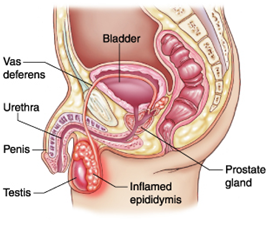Epididymitis Causes, Symptoms, Diagnosis and Treatment

What is Epididymitis?
Epididymitis is an inflammation of the tube that joins the testicle with the vas deferens. This happens most often in men under age 35 and is usually caused by a sexually transmitted infection. If men over the age of 35 get epididymitis, it is not usually caused by an STI. Less than 1% of men with an STI will get epididymitis.
Chronic infectious epididymitis is most often seen in conditions associated with granulomatous reaction; Mycobacterium tuberculosis (TB) is the most general granulomatous disease affecting the epididymis. Chronic epididymitis has been subcategorized into inflammatory chronic epididymitis, obstructive chronic epididymitis, and chronic epididymalgia
Causes of Epididymitis
Epididymitis is most common in young men ages 19 to 35. It is most often caused by the spread of a bacterial infection. Infection often begins in the urethra, the prostate, or the bladder. Gonorrhea and Chlamydia infections are most often the cause the problem in young heterosexual men. In children and older men, it is more usually caused by E. coli and similar bacteria. This is also true in homosexual men.
Mycobacterium tuberculosis (TB) can cause epididymitis. Other bacteria (such as Urea plasma) may also cause the condition.
Another cause of epididymitis is the use of a medicine called amiodarone, which prevents abnormal heart rhythms. Causes include:
- Urinary tract infections
- STIs, such as Chlamydia or gonorrhea
- Recent genitor-urinary surgery, including prostatectomy (the surgical removal of all or part of the prostate gland)
- Use of urinary catheters
- Congenital kidney and bladder problems
Symptoms of Epididymitis
Epididymitis may begin with a low fever, chills, and a feeling of heaviness in the testicle area. The area will get more receptive to pressure and become painful as the condition progress. An infection in the epididymis can easily spread to the testicle. The major symptoms of epididymitis include:
- Slight fever
- Chills
- Feeling of heaviness in the affected testicle
- Sensitivity to touch or pressure in the affected testicle
- Enlarged testicle
- Pain in the abdomen or pelvis
- Frequent urge to urinate
- Burning feeling when urinating
- Discharge from the penis
- Blood in the urine
- Pain when ejaculating.
Diagnosis of Epididymitis
It can be hard to tell the difference between epididymitis and testicular torsion, especially in younger men. Testicular torsion is when the testicle has twisted and cut off its supply of blood. Sometimes, epididymitis and testicular torsion occur at the same time. Epididymitis can be diagnosed using a number of tests, including:
- physical examination
- medical history
- urine tests
- STI tests
- blood tests
- ultrasound
Treatment of Epididymitis
The treatment options for epididymitis include:
- Antibiotics
- Antibiotics for any sexual partners (if an STI was the cause)
- Bed rest
- Pain-relieving medication
- Cold compresses applied regularly to the scrotum
- Elevation of the scrotum
- A stay in hospital (in cases of severe infection)
- Check-ups afterwards to make sure the infection has cleared up.
Patients should be instructed to abstain from sexual intercourse until they and their sex partners have been adequately treated (i.e. until therapy is completed and patient and partners no longer have symptoms).
By : Natural Health News




